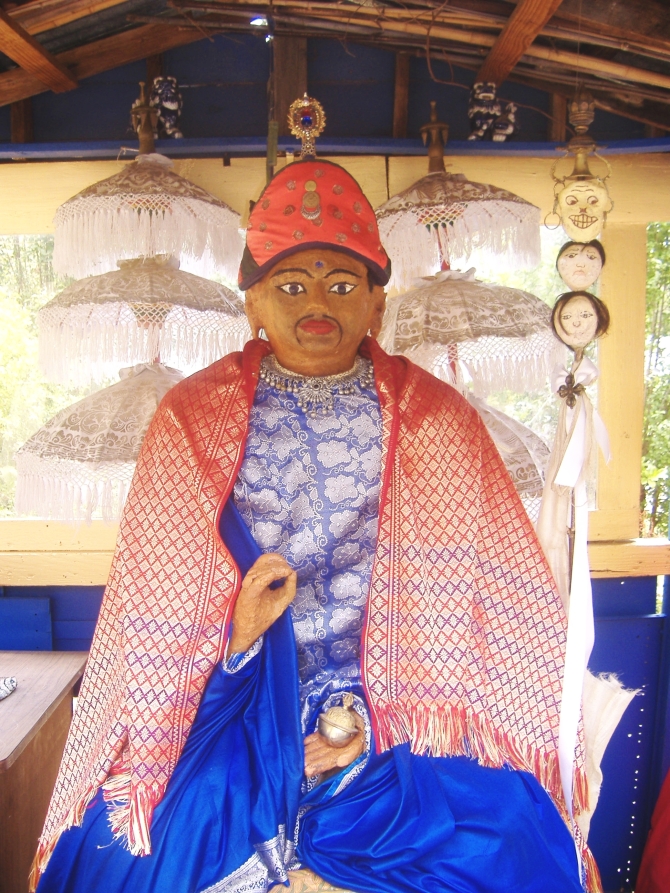Padmasambhava
Padmasambhava was a great Indian Master who introduced Buddha Dhamma to Tibet during the 8th Century AD. Guru Rinpoche, as he is commonly known in Tibetan Buddhism, overcame great obstacles to the propagation of the Buddha Dhamma in the Land of Snow (Tibet and the surrounding Himalayas), allowing the teachings to flourish on a grand scale. He is the founder of the Nyingma school of Tibetan Buddhism whose practitioners acknowledge him as the second Buddha. Padmasambhava is considered to be an emanation of Buddha Amitabha.

His significance and value to Buddhist Practitioners is articulated by Jigme Khyentse Rinpoche when he writes:
“He is the perfect teacher, the guide for those who wish to progress on the path; and all prayers addressed to him are of immense value… At whatever stage we are, beginners or otherwise, the Seven Line Prayer should be our constant companion. It is like a golden key to the treasure house of teachings. Above all, to recite the Seven Line Prayer is the best way to invoke Guru Rinpoche so that we can rest in his presence, cultivate devotion toward him and thus receive his blessings” – Jigme Khyentse Dordogne, 2006 1
History of Padmasambhava
According to the Tantras, Padmasambhava was born spontaneously from a lotus in the lake of Dhanakosha, in Oddiyana (modern day Pakistan)2. He was adopted by the local King Indrabodhi who raised Guru Rinpoche as his own son and named him heir to the kingdom3. Guru Rinpoche relinquished this future for the life of an ascetic where he undertook training and accomplishment in esoteric Buddha Dhamma4.
Around 761 AD, Padmasambhava was invited by the great monk and scholar Shantarakshita, Abbot of Nalanda, who on the behest of Tibetan King Trisongdetsen, was attempting to establish the Buddha Dhamma in Tibet. There was considerable resistance from the Tibetan nobility and ministers whose allegiance was to the traditional religion, a shamanistic faith known as Bon5.
Ven. Shantarakshita realised the greatest obstacle to the dissemination of Buddhist teachings were the old gods of Tibet as it is said they were the cause of a series of natural disasters that disrupted his efforts to establish the Buddha Dhamma6. Padmasambhava was requested to subdue these negative forces.
Guru Rinpoche used his formidable knowledge of the Dhamma to overwhelm the local Gods causing them to become compliant to his will, convincing many of them to become Buddhist. Guru Padmasambhava paved the way for the propagation of Buddha Dhamma and particularly the Vajrayana teachings throughout Tibet and the Himalayan region where it prospered unhindered for a thousand years7.
Such was his vision; he left many teachings to be discovered long after he departed Tibet. Known as ‘Termas’, these teachings are designed to be discovered when they are most needed. Even in the 20th Century hidden termas left by Padmasambhava continued to be discovered by various Tibetan Masters.
The extensive Padmasambhava practices taught widely in Tibetan Buddhism can be of immense benefit helping practitioners obtain direct Blessings for their realisation and attainment on the Buddhist Path from Guru Rinpoche who now resides in splendour in his Heavenly Kingdom.
Padmasambhava Practice
The Padmasambhava practice is best explained within the context of the relationship between a Buddhist practitioner and his teacher. For successful implementation of the practice, finding and attendance upon a qualified master or guru is imperative. This form of practice is called guru-yoga and it is designed to purify and deepen the disciple’s relationship with his or her teacher. For the student of the Nyingma school of Buddhism, Padmasambhava represent’s this ‘perfect teacher’ who possesses the ability to place the practitioner directly in the enlightened state8.
By reciting Padmasambhava’s mantra, practitioners are attempting to invoke his presence, receive his blessings and build a close relationship with him that can accelerate their progress towards enlightenment. It is said that Padmasambhava’s mantra has great purifying properties and can remove many obstacles from one’s path to enlightenment.
Padmasambhava’s main mantra is the Vajra Guru mantra. It is as follows:
Om Ah Hum, Vajra Guru Padma Siddhi Hung
‘Om’ signifies the body and essence of form. ‘Ah’ signifies speech and the essence of sound and ‘hum’ for the essence of spirituality. ‘Guru’ can be translated as the perfect teacher, ‘Padma’ is the first part of his name and ‘Siddhi’ refers to the attainments. ‘Hung’ is how we invoke the precious Guru requesting him to grant accomplishment9.
The Seven Line Prayer to Guru Rinponche is how we request the help and presence of Padmasmbhava. It is as follows:
Hung
Orgyen Yul Gyi Nup Chang Tsam
Hung. In the North-West Country of Odiyana
Pema Kesar Dongpo La
Born in the heart of a lotus
Yatsen Chok Gi Ngo Drup Nye
Endowed with the most marvellous spiritual attainments
Pema Jungne Shye Su Drak
You are renowned as the ‘Lotus Born’
Khor Du Khandro Mangpo Kor
Surrounded by a retinue of Dakinis
Khye Kyi Je Su Dak Drup Kyi
Following in your footsteps
Chin Gyi Lap Chir Shek Su Sol
I pray to you: Please come forth and grant your blessings!
Guru Pema Siddhi Hung
The first line indicates where Padmasambhava was born and the second line tells us how this occurred. The third line articulates the nature of his immense mastery and the fourth reveals his actual name. The fifth line describes his retinue of whom are a display of his compassion, helping beings according to their needs and by ‘following in your footsteps’ in the sixth line, it is demonstrated how to pray to Padmasambhava (with irreversible faith, gratitude and devotion). The seventh line expresses the blessings we receive and accomplishment we gain by reciting the Seven Line Prayer10.
The following link is an example of how to pronounce and chant the Seven Line Prayer. It was chanted by His Eminence Zimwock Rinpoche and we thank him for allowing us to use his rendition.
The Seven Line Prayer chanted by H. E. Zimwock Rinpoche (audio file):

About the Image at the Buddhist Discussion Centre
In 1994, after undertaking a three day retreat, Buddhist Discussion Centre Founder, the late John D. Hughes, resolved to build a Guru Padmasambhava image at our Centre with Padmasambhava’s blessings.
The image was built with clay dug up at our site using an ancient Chinese technique. After the internal structure of the image was completed, the clay was gradually applied in thin slurry layers and then left to dry by nature. These layers were applied hundreds of times until the image became smooth and was an accurate resemblance of Guru Padmasambhava. This process created many great causes or merit for those participating in the process.
Originally the image was built and housed outside in the centre’s garden with a cover being built over it to protect it from the weather. In 2006, our meditation hall was constructed around Guru Padmasambhava which is where he currently resides.
The 14 petal hollow lotus base of the image holds many, many mantras, sealed texts and offerings for future practitioners to rediscover 500 years from now, when the Image falls apart.
Our Centre’s Padmasambhava Image has been blessed on numerous occasions since its completion by senior Monks and Lama’s and it is used by our Teacher Anita Carter and students for healing and Blessings to help our Buddhist practice.
Bibliography
Mipham, Jamgon, Padmakara Translation Group (trans.), White Lotus: an Explanation of the Seven Line Prayer to Guru Padmasambhava, Massachusetts, Shambhala Publications, 2007
Rinpoche, Tulku Thondup, Talbott, Harold (ed.), Hidden Teaching of Tibet: An Explanation of the Terma Tradition of Tibetan Buddhism, Massachusetts, Wisdom Publications, 1997
Sarva-Antah, Mantras From Tibet, Fred Kosters, Sacred Music Series
Vesantara, A Guide to the Deities of the Tantra, Cambridge, Windhorse Publications Ltd, 2008
1 Jigme Khyentse Dordogne ‘Foreword’ in Jamgon Mipham and Padmakara Translation Group (trans.) White Lotus: An Explanation of the Seven Line Prayer to Guru Padmasambhava, Massachusetts, Shambhala Publications, 2007 p. xii
2 Ibid., p.5
3 Tulku Thondup Rinpoche, Hidden Teachings of Tibet: An Explantation of the Terma Tradition of Tibetan Buddhism, Massachusetts, Wisdom Publications, 1997, p.51
4 Ibid., p.50
5 Vessantara, A Guide to the Deities of the Tantra, Cambridge, Windhorse Publications Ltd., 2008, p.49
6 Mipham, p. 3
7 Mipham, p. 3
8 Mipham, pp 8-11
9 Mantras From Tibet, Sarvah-Antah, Fred Kosters, Sacred Music Series (liner notes)
10 Mipham, p.32


